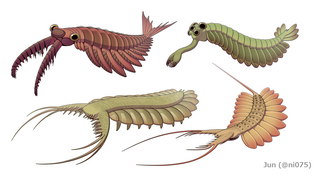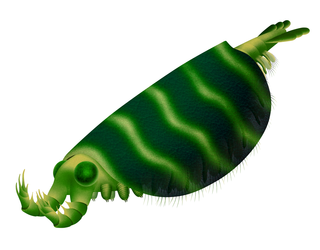Related Research Articles

Lobopodians are members of the informal group Lobopodia, or the formally erected phylum Lobopoda Cavalier-Smith (1998). They are panarthropods with stubby legs called lobopods, a term which may also be used as a common name of this group as well. While the definition of lobopodians may differ between literatures, it usually refers to a group of soft-bodied, marine worm-like fossil panarthropods such as Aysheaia and Hallucigenia.

Panarthropoda is a proposed animal clade containing the extant phyla Arthropoda, Tardigrada and Onychophora. Panarthropods also include extinct marine legged worms known as lobopodians ("Lobopodia"), a paraphyletic group where the last common ancestor and basal members (stem-group) of each extant panarthropod phylum are thought to have risen. However the term "Lobopodia" is sometimes expanded to include tardigrades and onychophorans as well.

Sea spiders are marine arthropods of the order Pantopoda, belonging to the class Pycnogonida, hence they are also called pycnogonids. They are cosmopolitan, found in oceans around the world. The over 1,300 known species have leg spans ranging from 1 mm (0.04 in) to over 70 cm (2.3 ft). Most are toward the smaller end of this range in relatively shallow depths; however, they can grow to be quite large in Antarctic and deep waters.

Dinocaridida is a proposed fossil taxon of basal arthropods that flourished in the Cambrian period with occasional Ordovician and Devonian records. Characterized by a pair of frontal appendages and series of body flaps, the name of Dinocaridids refers to the suggested role of some of these members as the largest marine predators of their time. Dinocaridids are occasionally referred to as the 'AOPK group' by some literatures, as the group compose of Radiodonta, Opabiniidae, and the "gilled lobopodians" Pambdelurion and Kerygmachela. It is most likely paraphyletic, with Kerygmachela and Pambdelurion more basal than the clade compose of Opabiniidae, Radiodonta and other arthropods.

The supraesophageal ganglion is the first part of the arthropod, especially insect, central nervous system. It receives and processes information from the first, second, and third metameres. The supraesophageal ganglion lies dorsal to the esophagus and consists of three parts, each a pair of ganglia that may be more or less pronounced, reduced, or fused depending on the genus:

The ventral nerve cord is a major structure of the invertebrate central nervous system. It is the functional equivalent of the vertebrate spinal cord. The ventral nerve cord coordinates neural signaling from the brain to the body and vice versa, integrating sensory input and locomotor output. Because arthropods have an open circulatory system, decapitated insects can still walk, groom, and mate—illustrating that the circuitry of the ventral nerve cord is sufficient to perform complex motor programs without brain input.

Kerygmachela kierkegaardi is a gilled lobopodian from the Cambrian Stage 3 aged Sirius Passet Lagerstätte in northern Greenland. Its anatomy strongly suggests that it, along with its relative Pambdelurion whittingtoni, was a close relative of radiodont (anomalocaridids) and euarthropods. The generic name "Kerygmachela" derives from the Greek words Kerygma (proclamation) and Chela (claw), in reference to the flamboyant frontal appendages. The specific name, "kierkegaardi" honors Danish philosopher Søren Kierkegaard.

The (pan)arthropod head problem is a long-standing zoological dispute concerning the segmental composition of the heads of the various arthropod groups, and how they are evolutionarily related to each other. While the dispute has historically centered on the exact make-up of the insect head, it has been widened to include other living arthropods, such as chelicerates, myriapods, and crustaceans, as well as fossil forms, such as the many arthropods known from exceptionally preserved Cambrian faunas. While the topic has classically been based on insect embryology, in recent years a great deal of developmental molecular data has become available. Dozens of more or less distinct solutions to the problem, dating back to at least 1897, have been published, including several in the 2000s.

Fuxianhuia is a genus of Lower Cambrian fossil arthropod known from the Chengjiang fauna in China. Its purportedly primitive features have led to its playing a pivotal role in discussions about the euarthropod stem group. Nevertheless, despite being known from many specimens, disputes about its morphology, in particular its head appendages, have made it one of the most controversial of the Chengjiang taxa, and it has been discussed extensively in the context of the arthropod head problem.

Homeobox protein SIX3 is a protein that in humans is encoded by the SIX3 gene.

engrailed is a homeodomain transcription factor involved in many aspects of multicellular development. First known for its role in arthropod embryological development, working in consort with the Hox genes, engrailed has been found to be important in other areas of development. It has been identified in many bilaterians, including the arthropods, vertebrates, echinoderms, molluscs, nematodes, brachiopods, and polychaetes. It acts as a "selector" gene, conferring a specific identity to defined areas of the body, and co-ordinating the expression of downstream genes.
Kenyon cells are the intrinsic neurons of the mushroom body, a neuropil found in the brains of most arthropods and some annelids. They were first described by F. C. Kenyon in 1896. The number of Kenyon cells in an organism varies greatly between species. For example, in the fruit fly, Drosophila melanogaster, there are about 2,500 Kenyon cells per mushroom body, while in cockroaches there are about 230,000.

Megacheira is an extinct class of predatory arthropods defined by their possession of spined "great appendages". Their taxonomic position is controversial, with studies either considering them stem-group euarthropods, or stem-group chelicerates. The homology of the great appendages to the cephalic appendages of other arthropods is also controversial. Uncontested members of the group were present in marine environments worldwide from the lower to middle Cambrian.

Radiodonta is an extinct order of stem-group arthropods that was successful worldwide during the Cambrian period. They may be referred to as radiodonts, radiodontans, radiodontids, anomalocarids, or anomalocaridids, although the last two originally refer to the family Anomalocarididae, which previously included all species of this order but is now restricted to only a few species. Radiodonts are distinguished by their distinctive frontal appendages, which are morphologically diverse and used for a variety of functions. Radiodonts included the earliest large predators known, but they also included sediment sifters and filter feeders. Some of the most famous species of radiodonts are the Cambrian taxa Anomalocaris canadensis, Hurdia victoria, Peytoia nathorsti, Titanokorys gainessii, Cambroraster falcatus and Amplectobelua symbrachiata, the Ordovician Aegirocassis benmoulai and the Devonian Schinderhannes bartelsi.
The cephalon is the head section of an arthropod. It is a tagma, i.e., a specialized grouping of arthropod segments. The word cephalon derives from the Greek κεφαλή (kephalē), meaning "head".

The labrum is a flap-like structure that lies immediately in front of the mouth in almost all extant Euarthropoda. The most conspicuous exceptions are the Pycnogonida, which probably are chelicerate-relatives. In entomology, the labrum amounts to the "upper lip" of an insect mouth, the corresponding "lower lip" being the labium.

Cardiodictyon is a genus of lobopodian known from 518 millions years old Chengjiang Lagerstätte. 525 millions years old partial fossil is also reported. It has ~25 pairs of legs, each associated with a pair of dorsal plates.

Euperipatoides kanangrensis is a species of velvet worm of the Peripatopsidae family, described in 1996 from specimens collected in Kanangra-Boyd National Park, New South Wales. This species has 15 pairs of legs in both sexes. It is endemic to Australia. The embryonic development of Euperipatoideskanangrensis has been described. This species is viviparous. This species is used as model organism for the last common ancestor of the Panarthropoda. It resembles fossil Cambrian lobopodians.

Cheloniellon is a monotypic genus of cheloniellid arthropod, known only by one species, Cheloniellon calmani, discovered from the Lower Devonian Hunsrück Slate of Germany.

Deuteropoda is a proposed clade of arthropods whose members are distinguished from more basal stem-group arthropods like radiodonts by an anatomical reorganization of the head region, namely the appearance of a differentiated first appendage pair, a multisegmented head, a hypostome/labrum complex, and by bearing pairs of segmented biramous limbs.
References
- 1 2 3 4 5 6 7 8 Steinmetz P.R.H., Urbach R., Posnien N., Eriksson J., Kostyuchenko R.P., Brena C., Guy K., Akam M., Bucher G., Arendt D. (2010). "~Six3~ demarcates the anterior-most developing brain region in bilaterian animals". EvoDevo. 1 (1): 14. doi: 10.1186/2041-9139-1-14 . PMC 3025827 . PMID 21190549.
{{cite journal}}: CS1 maint: multiple names: authors list (link) - ↑ Posnien, N., Koniszewski, N.D.B., Hein, H.J. and Bucher, G. 2011: Candidate gene screen in the red flour beetle tribolium reveals six3 as ancient regulator of anterior median head and central complex development. PLoS Genetics 7.
- ↑ Ortega-Hernandez, Javier; Janssen, Ralf; Budd, Graham E. (2017). "Origin and evolution of the panarthropod head – A palaeobiological and developmental perspective". Arthropod Structure & Development. 46 (3): 354–379. doi: 10.1016/j.asd.2016.10.011 . ISSN 1467-8039. PMID 27989966.
- ↑ Scholtz G., Edgecombe G.D. (2006). "The evolution of arthropod heads: reconciling morphological, developmental and palaeontological evidence". Development Genes and Evolution. 216 (7–8): 395–415. doi:10.1007/s00427-006-0085-4. PMID 16816969. S2CID 11300335.
- ↑ Hunnekuhl V.S., Akam M. (2014). "An anterior medial cell population with an apical-organ-like transcriptional profile that pioneers the central nervous system in the centipede Strigamia maritima". Developmental Biology. 396 (1): 136–149. doi: 10.1016/j.ydbio.2014.09.020 . PMID 25263198.
- ↑ Scholtz G., Edgecombe G.D. (2006). "The evolution of arthropod heads: reconciling morphological, developmental and palaeontological evidence". Development Genes and Evolution. 216 (7–8): 395–415. doi:10.1007/s00427-006-0085-4. PMID 16816969. S2CID 11300335.
- ↑ Strausfeld, Nicholas. Arthropod brains.
- ↑ Ortega-Hernández J., Janssen R., Budd G.E. (2017). "Origin and evolution of the panarthropod head – A palaeobiological and developmental perspective". Arthropod Structure & Development. 46 (3): 354–379. doi: 10.1016/j.asd.2016.10.011 . PMID 27989966.
{{cite journal}}: CS1 maint: multiple names: authors list (link) - ↑ Urbach R., Technau G.M. (2003). "Early steps in building the insect brain: Neuroblast formation and segmental patterning in the developing brain of different insect species". Arthropod Structure and Development. 32 (1): 103–123. doi:10.1016/s1467-8039(03)00042-2. PMID 18088998.
- ↑ Weygoldt, Peter. "Ontogeny of the arachnid central nervous system." Neurobiology of arachnids. Springer, Berlin, Heidelberg, 1985. 20-37.
- ↑ 2014: An anterior medial cell population with an apical-organ-like transcriptional profile that pioneers the central nervous system in the centipede Strigamia maritima. Developmental Biology 396, 136–149.
- ↑ Tae-Yoon S. Park, Kihm Ji-Hoon, Woo Jusun, Park Changkun, Young Lee Won, Smith M. Paul, Harper David A. T., Young Fletcher, Nielsen Arne T., Vinther Jakob (2018). "Brain and eyes of Kerygmachela reveal protocerebral ancestry of the panarthropod head". Nature Communications. 9 (1): 1019. Bibcode:2018NatCo...9.1019P. doi:10.1038/s41467-018-03464-w. PMC 5844904 . PMID 29523785.
{{cite journal}}: CS1 maint: multiple names: authors list (link)